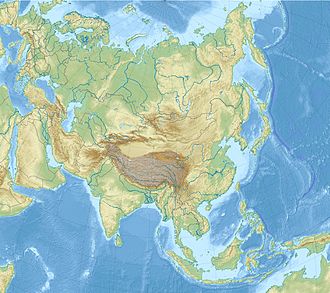Siege of Bamyan
| Siege of Bamyan | |||||||
|---|---|---|---|---|---|---|---|
| Part of the Mongol invasion of the Khwarazmian Empire | |||||||
 Ruins of Shahr-e-Gholghola | |||||||
| |||||||
| Belligerents | |||||||
| Mongol Empire | Khwarazmian Empire | ||||||
| Commanders and leaders | |||||||
| Genghis Khan | Jalal al-Din Mangburni | ||||||
| Casualties and losses | |||||||
| Heavy[1] | All killed[2] | ||||||
Location of the siege on a map of modern Afghanistan | |||||||
The siege of Bamyan (Dari: محاصره بامیان) took place in the spring of 1221 A.D. during the Mongol conquest of the Khwarazmian Empire. An army under the leadership of Genghis Khan, ruler of the Mongol Empire, who was in pursuit of Sultan Jalal al-Din Mangburni, the last ruler of the Khwarazmian Empire, Genghis Khan crossed the Hindu Kush and after that besieged the citadel of Shahr-e-Gholghola near Bamyan, northwest of Kabul, in present-day Afghanistan. The siege had led to a devastating attack that left the city in ruins.[3]
Events
[edit]The siege occurred in 1221 while the Mongols were pursuing Jalal al-Din Mangburni, the last ruler of the Khwarazmian Empire, where Jalal al-Din Mangburni had formed a new Muslim army in Afghanistan.[4] The city of Bamyan refused to give itself up to the Mongol army when they had approached.[5] During the siege the Mongol army led by Genghis Khan besieged the city of Bamyan.[6] The city possessed significant defensive fortifications. The Mongols continued their siege despite facing resistance. After considerable resistance the Mongols breached the walls and captured the city.[7] During the siege Mutukan, the eldest son of Chagatai Khan and beloved grandson of Genghis Khan, was killed in the battle by an arrow from the besieged city walls.[8] His death, coupled with the significant losses his army had suffered, is said to have prompted Genghis Khan to order the execution of the city’s inhabitants and the city’s destruction. The scale of destruction led to the city being referred as "the city of sorrows" and "the city of noise (or screams)".[9][10] Another account from the siege tells of Jalal al-Din Mangburni's daughter betraying the city by revealing its secret entrance to the Mongols.[11]
Following the siege Genghis Khan subsequently advanced in pursuit of Jalal al-Din Mangburni into the Delhi Sultanate territory.[12] Today the site of the ancient city of Bamyan is a UNESCO World Heritage Site,[13] Bamyan was unable to recover from this event for a long time. Even decades later, the city was still devastated, according to a report by a Persian historian.[14]
A common belief is that after the local Afghan population was annihilated, Genghis repopulated the area with some Mongolian soldiers and their slaves in order to garnish the region while continuing his campaign.[15]
References
[edit]- ^ Kohn, George C (2007). Dictionary of Wars. New York : Facts on File/Checkmark Books. p. 55.
- ^ Sverdrup, Carl Fredrik (2017). The Mongol Conquests: The Military Operations of Genghis Khan and Sube'etei. p. 347. Retrieved 2025-04-23.
- ^ "City of Screams: Gholghola". Visit Bamiyan. 4 June 2020. Retrieved 2025-02-04.
- ^ Kohn, George C (2007). Dictionary of Wars. New York : Facts on File/Checkmark Books. p. 55.
- ^ Hartog, Leo de (2004). Genghis Khan : Conqueror of the World. London ; New York : Taurisparke Paperbacks. p. 113.
- ^ Kohn, George C (1986). Dictionary of Wars. New York, N.Y. : Facts on File. ISBN 0816010056. p. 48.
- ^ Morgan, Llewelyn (2012). The Buddhas of Bamiyan. Cambridge, Mass. : Harvard University Press. ISBN 9780674057883. p. 36.
- ^ Behnke, Alison (2008). The Conquests of Genghis Khan. Minneapolis : Twenty-First Century Books. ISBN 9780822575191. p. 106.
- ^ "Remembering Bamiyan". Kashgar.com.au. Archived from the original on 4 October 2013. Retrieved 9 October 2013.
- ^ Roux, Jean-Paul (2003). Genghis Khan and the Mongol Empire. New York : Harry N. Abrams. ISBN 0810991039. p. 124.
- ^ "City of Screams: Gholghola". Visit Bamiyan. 4 June 2020. Retrieved 2025-02-04.
- ^ Behnke, Alison (2008). The Conquests of Genghis Khan. Minneapolis : Twenty-First Century Books. ISBN 9780822575191. p. 107.
- ^ "Cultural Landscape and Archaeological Remains of the Bamiyan Valley". UNESCO World Heritage Centre. Archived from the original on 28 January 2007. Retrieved 2 August 2022.
- ^ Foundation, Encyclopaedia Iranica. "Welcome to Encyclopaedia Iranica". iranicaonline.org. Retrieved 2021-08-14.
- ^ James, Minahan (2007). Encyclopedia of the stateless nations : ethnic and national groups around the world. Westport, Conn. : Greenwood Press. p. 728.


